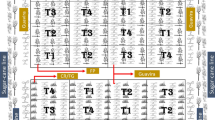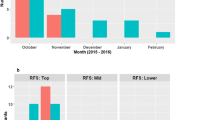Abstract
Giant miscanthus (Miscanthus × giganteus) and giant reed (Arundo donax) are leading bioenergy crops. Both exhibit many invasive characteristics, though only giant reed is known to be invasive. Despite this, neither produces viable seed, limiting movement to vegetative propagules. Therefore, to assess vegetative fragments as potential propagules, we quantified seasonal changes in culm node viability and performance in giant miscanthus and giant reed under greenhouse conditions. Giant miscanthus culms were collected in spring, summer, fall, and winter from established fields, while giant reed culms were collected in summer, fall, and winter from feral stands. Treatments at each timing consisted of whole culms and single-node culm fragments planted in soil or placed in standing water for an 8-week period. Giant miscanthus whole culms and fragments produced shoots and roots in both soil and standing water immediately following cutting from spring to summer, but failed to produce shoots and roots after fall and winter cutting dates. All rhizome fragments survived and generated shoots and roots after burial. By comparison, giant reed produced shoots and roots in both soil and standing water throughout the year, regardless of cutting date. With giant miscanthus, precautions should be taken when living culms or rhizome fragments are harvested and transported through riparian habitats during the summer months. By comparison, giant reed showed a remarkable increase in propagule generation and productivity throughout the year and, thus, escaped propagules present a far greater risk of unintentional establishment compared to giant miscanthus.





Similar content being viewed by others
References
United States Energy Information Administration (2012) Ethanol production in the US. Posted January 1. Available at http://www.eia.gov
Georgescu M, Lobell DB, Field CB (2011) Direct climate effects of perennial bioenergy crops in the United States. Proc Nat Acad Sci USA 108(11):4307–4312
Fernando AL, Duarte MP, Almeida J, Boleo S, Mendes B (2010) Environmental impact assessment of energy crops cultivation in Europe. Biofuels, Bioprod Biorefin 4(6):594–604
Tilman D, Socolow R, Foley JA, Hill J, Larson E, Lynd L et al (2009) Beneficial biofuels—the food, energy, and environment trilemma. Science 325(5938):270–271
Sims REH, Mabee W, Saddler JN, Taylor M (2010) An overview of second generation biofuel technologies. Bioresour Technol 101(6):1570–1580
Jessup RW (2009) Development and status of dedicated energy crops in the United States. Vitro Cellular & Developmental Biology-Plant 45(3):282–290
Heaton EA, Dohleman FG, Long SP (2008) Meeting US biofuel goals with less land: the potential of Miscanthus. Glob Chang Biol 14(9):1–14
Energy Independence and Security Act, in H.R. (2007) USA 2007
McDonald RI, Fargione J, Kiesecker J, Miller WM, Powell J (2009) Energy sprawl or energy efficiency: climate policy impacts on natural habitat for the United States of America. PLoS One 4(8):e6802. doi:10.1371/journal.pone.0006802
Robertson GP, Dale VH, Doering OC, Hamburg SP, Melillo JM, Wander MM et al (2008) Agriculture—sustainable biofuels redux. Science 322(49):49–50
Field CB, Campbell JE, Lobell DB (2008) Biomass energy: the scale of the potential resource. Trends in Ecology and Evolution 23(2):65–72
Perlack D, Wright L, Turhollow F, Graham R, Stokes B, Erback D (2005) Biomass as feedstock for a bioenergy and bioproducts industry: the technical feasibility of a billion-ton annual supply. Oak Ridge National Laboratory: USDA/DOE
Richardson DM, Blanchard R (2010) Learning from our mistakes: minimizing problems with invasive biofuel plants. Current Opinion in Environmental Sustainability 3(1–2):36–42
Barney JN, DiTomaso JM (2010) Invasive species biology, ecology, management and risk assessment: evaluating and mitigating the invasion risk of biofuel crops. In: Mascia P, Scheffran J, Thomas S, Widlholm J (eds) Biotechnology in agriculture and forestry. Springer, New York, pp 263–284
Zub HW, Brancourt-Hulmel M (2010) Agronomic and physiological performances of different species of Miscanthus, a major energy crop. A review. Agronomy for Sustainable Development 30(2):201–214
Mariani C, Cabrini R, Danin A, Piffanelli P, Fricano A, Gomarasca S et al (2010) Origin, diffusion and reproduction of the giant reed (Arundo donax L.): a promising weedy energy crop. Ann Appl Biol 157(2):191–202
Mantineo M, D'Agosta GM, Copani V, Patane C, Cosentino SL (2009) Biomass yield and energy balance of three perennial crops for energy use in the semi-arid Mediterranean environment. Field Crops Research 114(2):204–213
Angelini LG, Ceccarini L, Di Nassa NNO, Bonari E (2009) Comparison of Arundo donax L. and Miscanthus × giganteus in a long-term field experiment in central Italy: analysis of productive characteristics and energy balance. Biomass Bioenergy 33(4):635–643
Heaton EA, Dohleman FG, Long SP (2009) Seasonal nitrogen dynamics of Miscanthus × giganteus and Panicum virgatum. Global Change Biology Bioenergy 1(4):297–307
Low T, Booth C, Sheppard A (2011) Weedy biofuels: what can be done? Current Opinion in Environmental Sustainability 3(1):55–59
DiTomaso JM, Reaser JK, Dionigi CP, Doering OC, Chilton E, Schardt JD et al (2010) Biofuel vs bioinvasion: seeding policy priorities. Environ Sci Technol 44(18):6906–6910
Barney JN, DiTomaso JM (2008) Nonnative species and bioenergy: are we cultivating the next invader? Bioscience 58(1):64–71
Raghu S, Anderson RC, Daehler CC, Davis AS, Wiedenmann RN, Simberloff D et al (2006) Adding biofuels to the invasive species fire? Science 313(5794):1742
Mack RN (2008) Evaluating the credits and debits of a proposed biofuel species: giant reed (Arundo donax). Weed Sci 56(6):883–893
Glowacka K (2011) A review of the genetic study of the energy crop Miscanthus. Biomass Bioenergy 35(7):2445–2454
Matlaga DP, Schutte BJ, Davis AS (2012) Age-dependent demographic rates of the bioenergy crop Miscanthus × giganteus in Illinois. Invasive Plant Sci Manage 5(2):238–248
Lambert AM, Dudley TL, Saltonstall K (2010) Ecology and impacts of the large-statured invasive grasses Arundo donax and Phragmites australis in North America. Invasive Plant Science and Management 3(4):489–494
Bell GP (1997) Ecology and management of Arundo donax, and approaches to riparian habitat restoration in southern California. Plant Invasions: Studies from North America and Europe 56:103–113
Theoharides KA, Dukes JS (2007) Plant invasion across space and time: factors affecting nonindigenous species success during four stages of invasion. New Phytol 176(2):256–273
Lockwood JL, Cassey P, Blackburn TM (2009) The more you introduce the more you get: the role of colonization pressure and propagule pressure in invasion ecology. Divers Distrib 15(5):904–910
Gordon DR, Tancig KJ, Onderdonk DA, Gantz CA (2011) Assessing the invasive potential of biofuel species proposed for Florida and the United States using the Australian Weed Risk Assessment. Biomass Bioenergy 35(1):74–79
Jorgensen U (2011) Benefits versus risks of growing biofuel crops: the case of Miscanthus. Current Opinion in Environmental Sustainability 3(1–2):24–30
Byrne M, Stone L (2011) The need for ‘duty of care’ when introducing new crops for sustainable agriculture. Current Opinion in Environmental Sustainability 3(1–2):50–54
Decruyenaere JG, Holt JS (2005) Ramet demography of a clonal invader, Arundo donax (Poaceae), in Southern California. Plant Soil 277(1–2):41–52
Atkinson CJ (2009) Establishing perennial grass energy crops in the UK: a review of current propagation options for Miscanthus. Biomass Bioenergy 33(5):752–759
Hong J, Meyer M (2007) Effect of medium, date, and node position on rooting of Miscanthus × giganteus stem cuttings. Hortscience 42(4):910
DEFRA, NF0415 (1992) Investigation of stem rooting in Miscanthus. Final Report
Decruyenaere JG, Holt JS (2001) Seasonality of clonal propagation in giant reed. Weed Science 49(6):760–767
Ceotto E, Di Candilo M (2010) Shoot cuttings propagation of giant reed (Arundo donax L.) in water and moist soil: the path forward? Biomass Bioenergy 34(11):1614–1623
Lambers H, Chapin FS III, Pons TL (eds) (2008) Plant physiological ecology, 2nd edn. Springer, New York
Wijte A, Mizutani T, Motamed ER, Merryfield ML, Miller DE, Alexander DE (2005) Temperature and endogenous factors cause seasonal patterns in rooting by stem fragments of the invasive giant reed, Arundo donax (Poaceae). International Journal of Plant Science 166(3):507–517
Christian DG, Yates NE, Riche AB (2009) Estimation of ramet production from Miscanthus × giganteus rhizome of different ages. Ind Crop Prod 30(1):176–178
Pyter R, Heaton E, Dohleman F, Voigt T, Long S (2009) Agronomic experiences with Miscanthus × giganteus in Illinois, USA. Biofuels: Methods and Protocols 581:41–52
Huisman WK, Kortleve WJ (1994) Mechanization of crop establishment, harvest, and post-harvest conservation of Miscanthus sinensis Giganteus. Ind Crop Prod 2:289–297
Pyter RJ, Dohleman FG, Voigta TB (2010) Effects of rhizome size, depth of planting and cold storage on Miscanthus × giganteus establishment in the Midwestern USA. Biomass Bioenergy 34(10):1466–1470
Heaton EA, Dohleman FG, Miguez AF, Juvik JA, Lozovaya V, Widholm J et al (2010) Miscanthus: a promising biomass crop. Adv Bot Res 56:75–137
Honnay O, Jacquemyn H (2010) Clonal plants: beyond the patterns—ecological and evolutionary dynamics of asexual reproduction. Evol Ecol 24(6):1393–1397
Liu J, Dong M, Miao SL, Li Z, Song MH, Wang RQ (2006) Invasive alien plants in China: role of clonality and geographical origin. Biological Invasions 8(7):1461–1470
Barney JN, Whitlow TH (2008) A unifying framework for biological invasions: the state factor model. Biological Invasions 10(3):259–272
Catford JA, Jansson R, Nilsson C (2009) Reducing redundancy in invasion ecology by integrating hypotheses into a single theoretical framework. Divers Distrib 15:22–40
Barney JN, Mann JJ, Kyser GB, DiTomaso JM (2012) Assessing habitat susceptibility and resistance to invasion by the bioenergy crops switchgrass and Miscanthus × giganteus in California. Biomass Bioenergy 40:143–154
Nilsson C, Brown RL, Jansson R, Merritt DM (2010) The role of hydrochory in structuring riparian and wetland vegetation. Biol Rev 85(4):837–858
Spencer DF, Liow PS, Chan WK, Ksander GG, Getsinger KD (2006) Estimating Arundo donax shoot biomass. Aquat Bot 84(3):272–276
Meyerson LA (2008) Biosecurity, biofuels, and biodiversity. Front Ecol Environ 6:291
Acknowledgments
We would like to thank Chris van Kessel for reviewing the manuscript and Carlos Figueroa and Rachel Brownsey for their help with the experiment.
Author information
Authors and Affiliations
Corresponding author
Rights and permissions
About this article
Cite this article
Mann, J.J., Kyser, G.B., Barney, J.N. et al. Assessment of Aboveground and Belowground Vegetative Fragments as Propagules in the Bioenergy Crops Arundo donax and Miscanthus × giganteus . Bioenerg. Res. 6, 688–698 (2013). https://doi.org/10.1007/s12155-012-9286-z
Published:
Issue Date:
DOI: https://doi.org/10.1007/s12155-012-9286-z




